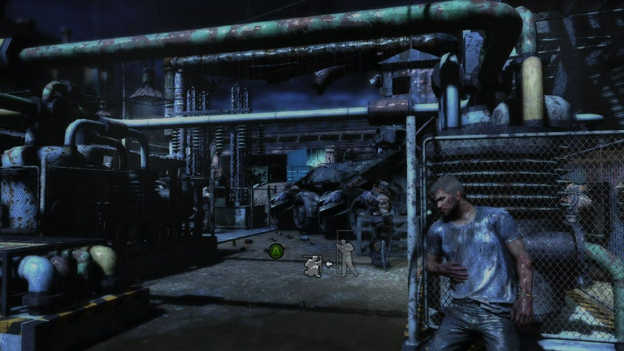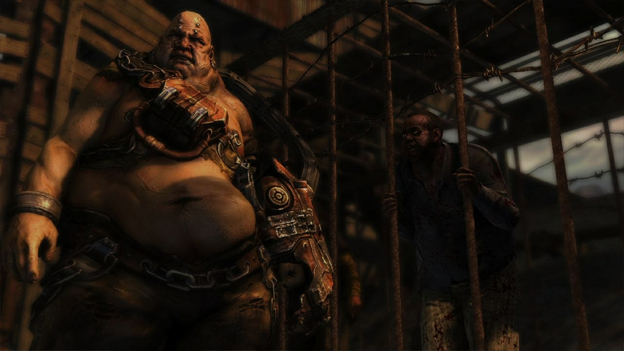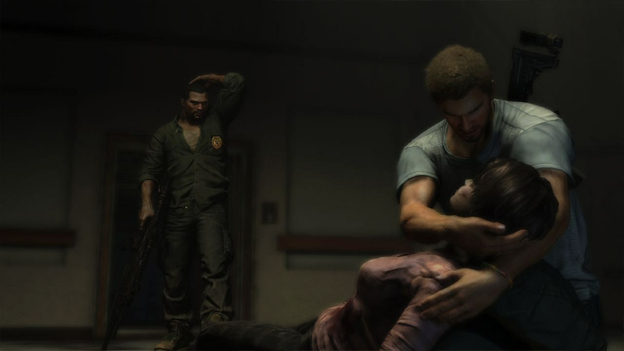Gears of Gravity
Inversion doesn’t pretend to be anything it’s not. It’s a Gears of War knockoff, albeit one with a grab bag of gravity-related features thrown into the mix. Besides the stolen cover system, the “roadie run,” and the similar graphics, one of your weapons is even an assault rifle with a scary bayonet attachment.
And that’s fine. Gears of War is a great franchise, and a well-made imitation could be an enjoyable experience. A blend of extra gimmicks could give Inversion something special to help it stand out. But unfortunately, even though the developers had a perfect template to work off of, they managed to insert enough design flaws to make Inversion an unworthy buy. Not only does it lack the polish of its big-budget competitor, but it can be downright frustrating to play.

To be fair, the first two-thirds of the seven-hour campaign are fun. This is a game where you and a partner hide behind cover and then pop out and shoot stuff, and it’s almost impossible to screw that up. So long as a gamer is slaughtering aliens, not dying unfairly, and not being forced to revive his buddy too often, he’s a happy gamer. On my very first sitting, I got more than three hours into the campaign and loved almost every minute of it.
And to spice things up, there are a variety of gravity effects. After some Metroid-style teasing — you get all the features at the beginning of the game, but then they’re taken away — you end up with a full arsenal of ways to attack your enemies. Using your handy “Gravlink,” you can manipulate the Earth’s gravitational field however you’d like.

You can reduce gravity to make small items float. Then, in a nod to Half-Life 2’s Gravity Gun, you can grab the items and throw them at enemies. There’s a ground-pound maneuver for when bad guys get too close, and you can increase gravity to pull down things that are suspended in midair or bring big enemies to their knees. There are also sections scattered through the game that combine the zero-gravity segments of Dead Space with the cover mechanics of Gears of War; the idea is that you float from one piece of cover to another, shooting enemies all the way. And finally, in certain parts of the game the world will flip sideways, Prey-style, so that you’re walking on the walls or the ceiling.
As you can tell from the fact that I’m constantly citing other games, very little of this is actually new. And even when Inversion is at its best, it’s easy enough to point out the flaws. The graphics, while an admirable attempt to ape the Gears of War style, don’t have the detail and polish of their inspiration. The story is a total cliche–aliens are taking over the Earth, and you’re a gruff cop who’s trying to find his daughter. There are too many cutscenes and too few enemy types. The developers didn’t implement the cover system carefully enough. Sometimes the gravity effects can be clumsy to control, and most of the time it’s entirely possible to ignore your Gravlink and play Inversion as a standard shooter.

But you know what? None of that changes the fact that Inversion can be fun. If the issues mentioned in the previous paragraph were the only ones, I wouldn’t hesitate to recommend Inversion as a rental or a bargain-bin buy.
Then all hell breaks loose in about the last third of the campaign, and it’s hard to forgive the level of frustration you’re forced to deal with as you stagger your way toward the title’s merciful conclusion. The difficulty ramps up as you face stronger enemies with more dangerous weapons, and what was once a light and pleasant experience becomes a dreary slog. If you’re playing alone, you’ll notice that your AI partner is feeling the stress, too, as he bites the dust with increasing frequency. Even the plot, which wasn’t exactly Robert Heinlein to begin with (though the game is dedicated to him), takes a turn for the worse.

Then there are the boss fights. Oh my god , the boss fights. They’re overly difficult, too frequent, and repetitive. And by “repetitive,” I don’t mean that you have to keep doing the same thing over and over again to win — though there’s that too. By “repetitive” I mean that you fight the same exact freaking bosses multiple times.
Hands down, the most obnoxious one is the Slave Driver, a fat guy with a whip, legions of minions, and at least twice as much health as any reasonable game designer would give him. He’s protected by a shield, and to get the shield to come down, you have to kill a wave of his followers. Unfortunately, the minions aren’t normal enemies with guns; instead, they’re deranged, fast-moving monsters armed with melee weapons, so you have to run around the arena erratically to avoid them, praying that you won’t get caught on an object or sucked into cover unexpectedly. (You can try hitting them with your own melee attack, but you’ll quickly discover that it’s almost unusable, especially once an enemy is on top of you.) If you let a minion or the Slave Driver himself get too close, you’ll be dead after just a few hits, and you get to start all over again.
Eventually, Slave Driver “dies,” and you can play the game in peace for a bit before you come across him again. And again. And again.
If you get sick of screaming profanity at your TV and making your wife mad (or maybe that’s just me), you can try the multiplayer modes instead. (Quick note: Multiplayer is online only, which angered some customers who’d been promised otherwise.) Co-op solves the problems with the partner AI, and makes the boss fights a little easier to boot. The competitive modes are pretty buggy, but they’re fun in a ridiculous kind of way. In addition to the standard Gears modes (deathmatch, horde, etc.), there are a few gameplay types that take advantage of the gravity features.
In King of Gravity, all the players fight for control of a single Gravlink–the only way to get points is to get the Gravlink and rack up kill streaks, and the Gravlink provides you a huge tactical advantage over all the other players who are trying to kill you. In Gravity Slaughter, you need to kill your foes with your gravity powers, and in Grav Control, a kill streak earns you the right to flip the arena’s gravity so that the layout changes.
With more polish and better use of its gravity gimmicks, Inversion could have been something truly special. And even without that, Inversion could have been a great way to waste a weekend, if only the developers hadn’t let the campaign go off the rails toward the end. Instead, what we’re left with is two-thirds of a campaign that competently rips off Gears of War, and some multiplayer modes that aren’t bad. That’s not enough to justify a rental, much less a $60 purchase.
RATING OUT OF 5 RATING DESCRIPTION 3.2 Graphics
The style is similar to Gears of War, but the level of detail and polish falls short. 3.0 Control
For the most part they’re fine, but some of the gravity effects can be clumsy to control, and the cover system is glitchy. 3.5 Music / Sound FX / Voice Acting
The voice acting is decent, though it doesn’t improve the awful story, and the sound effects and music are fine. 2.7 Play Value
Inversion doesn’t do anything other games don’t, and the final stretch of the campaign is unbearable. 3.0 Overall Rating – Fair
Not an average. See Rating legend below for a final score breakdown.
| Review Rating Legend | |||
|---|---|---|---|
| 0.1 – 1.9 = Avoid | 2.5 – 2.9 = Average | 3.5 – 3.9 = Good | 4.5 – 4.9 = Must Buy |
| 2.0 – 2.4 = Poor | 3.0 – 3.4 = Fair | 4.0 – 4.4 = Great | 5.0 = The Best |
Game Features:
